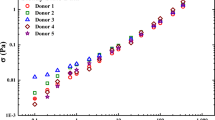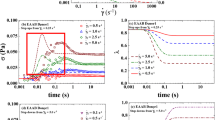Abstract
The rheological characterization of a human blood, through modeling and analysis of transient flows and large-amplitude oscillatory shear (LAOS) flow, has made tremendous progress recently. We show how various components, and modifications of two recent scalar, structural kinetic, thixotropic models, can offer several modeling and prediction improvements, and compare our results to the Maxwell-like Bautista-Manero-Puig (BMP) model, and a recent transient model based on the Herschel-Bulkley. We explore the weakness of the legacy blood models, and then, we apply this newly improved model to recently published data from the literature in order to demonstrate its efficacy in modeling steady state, transient, and oscillatory shear flow. Following this effort, we demonstrate a novel approach using the sequence of physical phenomena (SPP) to facilitate interpretation, characterization, mapping, and “fingerprinting” of transient blood data from the literature. We compare the SPP approach to other LAOS analysis techniques in the literature and show how our approach can function as a mechanical-property diagnostic blood analysis tool. The goal of this work is a deeper understanding of the microstructural basis and validity of structural thixotropic blood models, and transient flow analysis techniques and procedures.






















Similar content being viewed by others
References
Akaike H (1974) A new look at the statistical model identification. IEEE Trans Autom Control AC-19(6)
Apostolidis AJ, Armstrong MJ, Beris AN (2015) Modeling of human blood rheology in transient shear flows. J Rheol 59:275–298
Apostolidis AJ, Beris AN (2014) Modeling the blood rheology in steady-shear flows. J Rheol (1978-Present) 58(3):607–633
Apostolidis AJ, Beris AN (2015) The effect of cholesterol and triglycerides on the steady state rheology of blood. Rheol Acta 1:1–13
Apostolidis AJ, Moyer AP, Beris AN (2016) Non-Newtonian effects in simulations of coronary arterial blood flow. J Non-Newton Fluid Mech 233:155–165
Armstrong MJ (2015) Investigating and modeling the thixotropic behavior, microstructure and rheology of complex material. Ph.D. Thesis, University of Delaware
Armstrong MJ, Beris AN, Rogers SA, Wagner NJ (2016a) Dynamic shear rheology of a thixotropic suspension: comparison of an improved structure-based model with large amplitude oscillatory shear experiments. J Rheol 60:433–450
Armstrong MJ, Beris AN, Rogers SA, Wagner NJ (2017) Dynamic shear rheology and structure kinetics modeling of a thixotropic carbon black suspension. Rheol Acta 56(10):811–824
Armstrong MJ, Beris AN, Wagner NJ (2016b) An adaptive parallel tempering method for the dynamic data-driven parameter estimation of nonlinear models. AICHE J. 10.1002/aic.15577
Barbee JH, Cokelet GR (1971) Prediction of blood flow in tubes with diameters as small as 29 microns. Microvasc Res 3:17–21
Barnes HA (1997) Thixotropy—a review. J Non-Newtonian Fluid Mech 70(1–2):1–33
Baskurt KO, Boynard M, Cokelet GC, Connes P, Cooke BM, Forconi S, Liao F, Hardeman MR, Jung F, Meiselman HJ, Nash G, Nemeth N, Neu B, Sandhagen B, Shin S, Thurston G, Wautier JL (2009) New guidelines for hemorheological laboratory techniques. Clin Hemorheol Microcirc 42:75–97
Bautista F, De Santos JM, Puig JE, Manero O (1999) Understanding thixotropic and antithixotropic behavior of viscoelastic micellar solutions and liquid crystalline dispersions. J Non-Newtonian Fluid Mech 80:93–113
Beris AN, Stiakakis E, Vlassopoulos D (2008) A thermodynamically consistent model for the thixotropic behavior of concentrated star polymer suspensions. J Non-Newtonian Fluid Mech 152:76–85
Bessonov N, Sequeira A, Simakov S, Vassilevskii Y, Volpert V (2016) Methods of blood flow modeling. Math Model Nat Phenom 11(1):1–25
Bharadwaj AN, Ewoldt R (2014) The general low-frequency prediction for asymptotically nonlinear material functions in oscillatory shear. J Rheol 58(4):891–910
Bharadwaj AN, Ewoldt R (2015) Constitutive fingerprints in medium-amplitude oscillatory shear. J Rheol 59(2):557–592
Bird RB, Armstrong R, Hassager O (1987) Dynamics of polymeric liquids. John Wiley and Sons, NY
Blackwell B, Ewoldt R (2014) A simple thixotropic-viscoelastic constitutive model produces unique signatures in large-amplitude oscillatory shear (LAOS). J Non-Newtonian Fluid Mech 208-209:27–41
Bureau M, Healy JC, Bourgoin D, Joly M (1979) Etude rhéologique en régime transitoire de quelques échantillons de sangs humains artificiellement modifiés. Rheol Acta 18:756–768
Bureau M, Healy JC, Bourgoin D, Joly M (1980) Rheological hysteresis of blood at low shear rate. Biorheology 17:191–203
Coussot P (2017) Bingham’s heritage. Rheol Acta. https://doi.org/10.1007/s00397-016-0983-y
de Souza Mendes PR, Thompson RL (2012) A critical overview of elasto-viscoplastic thixotropic modeling. JNNFM 187-188: 8-15
de Souza Mendes PR, Thompson RL (2013) A unified approach to model elasto-viscoplastic thixotropic yield-stress materials and apparent yield-stress fluids. Rheol Acta 52:673–694
Dimitriou CJ, Ewoldt RH, McKinley GH (2012) Describing and prescribing the constitutive response of yield stress fluids using large amplitude oscillatory shear stress (LAOStress). J Rheol 57:27–70
Dullaert K, Mewis J (2006) A structural kinetics model for thixotropy. J Non-Newtonian Fluid Mech 139(1–2):21–30
Ewoldt RH (2013) Defining nonlinear rheological material functions for oscillatory shear. J Rheol 57:177–195
Ewoldt R, Bharadwaj AN (2013) Low-dimensional intrinsic material functions for nonlinear viscoelasticy. Rheol Acta 52:201–219
Ewoldt RH, Hosoi AE, McKinley GH (2008) New measures for characterizing nonlinear viscoelasticity in large amplitude oscillatory shear. J Rheol 52(6):1427–1458
Ewoldt RH, McKinley GH (2017) Mapping thixo-elastic-visco-plastic behavior. Rheol Acta 56:195–210
Ewoldt RH, Winter P, Maxey J, McKinley GH (2010) Large amplitude oscillatory shear of pseudoplastic and elastoviscoelastic material. Rheol Acta 49:191–212
Flormann D, Schirra K, Podgorski T, Wagner C (2016) On the rheology of red blood cell suspensions with different amounts of dextran: separating the effect of aggregation and increase in viscosity of the suspending phase. Rheol Acta 55:477–483
Germann N, Gurnon AK, Zhou L, Cook LP, Beris AN, Wagner NJ (2016) Validation of constitutive modeling of shear banding, threadlike wormlike micellar fluids. J Rheol 60:983–999
Giacomin AJ, Dealy JM (1993) Large-amplitude oscillatory shear. Techniques in Rheological Measurement. Chapman and Hall
Goodeve CF (1939) A general theory of thixotropy and viscosity. Trans Faraday Society 35:342–358
Gurnon AK, Wagner NJ (2012) Large amplitude oscillatory shear (LAOS) measurements to obtain constitutive equation model parameters: Giesekus model of banding and nonbanding wormlike micelles. J Rheol 56(2):333–351
Herrera-Valencia EE, Calderas F, Medina-Torres L, Perez-Camacho M, Moreno L, Manero O (2017) On the pulsating flow behavior of a biological fluid: human blood. Rheol Acta doi. https://doi.org/10.1007/s00397-017-0994-3
Hyun K, Wilhelm M, Klein CO, Kwang SC, Jung GN, Kyung HA, Seung JL, Ewoldt RH, McKinley GH (2011) A review of nonlinear oscillatory shear tests: analysis and application of large amplitude oscillatory shear (LAOS). Prog Polym Sci 36:1697–1753
Larson RG (2015) Constitutive equations for thixotropic fluids. J Rheol 59:595–611
Malkin A, Kulichikhin V, Ilyin S (2017) A modern look on yield stress fluids. Rheol Acta. https://doi.org/10.1007/s00397-016-0963-2
Merger D, Abbasi M, Merger J, Giacomin AJ, Saengow C, Wilhelm M (2016) Simple scalar model and analysis for large amplitude oscillatory shear. Appl Rheol. https://doi.org/10.3933/APPLRHEOL-26-53809
Merill E (1969) Rheology of blood. Physiol Rev 49:(4)
Mewis J (1979) Thixotropy—a general review. J Non-Newtonian Fluid Mech 6:1–20
Mewis J, Wagner NJ (2009) Thixotropy. Adv Coll Int Sci 147-148:214–227
Mewis J, Wagner NJ (2012) Colloidal suspension rheology. Cambridge University Press, NY
Moreno L, Calderas F, Sanchez-Olivares G, Medina-Torres L, Sanchez-Solis A, Manero O (2015) Effect of cholesterol and triglycerides levels on the rheological behavior of human blood. Korea-Australia Rheology Journal 27(1):1–10
Mujumdar A, Beris AN, Metzner AB (2002) Transient phenomena in thixotropic systems. J Non-Newtonian Fluid Mech 102:157–178
Pressley A (ed) (2010) Elementary differential geometry. Springer, London
Rogers SA (2012) A sequence of physical processes determined and quantified in LAOS: an instantaneous local 2D/3D approach. J Rheol 56(5):1129–1151
Rogers SA (2017) In search of physical meaning: defining transient parameters for nonlinear viscoelasticity. Rheol Acta. https://doi.org/10.1007/s00397-017-1008-1
Rogers SA, Lettinga MP (2012) A sequence of physical processes determined and quantified in large-amplitude oscillatory shear (LAOS): application to theoretical nonlinear models. J Rheol 56(1):1–25
Saramito P (2009) A new elastoviscoplastic model based on the Herschel-Bulkley viscoplastic model. J Non-Newtonian Fluid Mech 158:154–161
Sousa PC, Carneiro K, Vaz R, Cerejo A, Pinho FT, Alves MA, Oliveira MS (2013) Shear viscosity and nonlinear behavior of whole blood under large amplitude oscillatory shear. Biorheology 50(5–6):269–282
Sousa PC, Pinho FT, Alves MA, Oliveira M (2016) A review of hemorheology: measuring techniques and recent advances
Stickel J, Knutsen JS, Libertore MW (2013) Response of elastoviscoplastic materials to large amplitude oscillatory shear flow in the parallel-plate and cylindrical-Couette geometries. J Rheol 57(6):1569–1596
Tomaiuolo G, Carciata A, Caserta S, Guido S (2016) Blood linear viscoelasticity by small amplitude oscillatory flow. Rheol Acta 55:485–495
Valant AZ, Ziberna L, Papaharilaou Y, Anayiotos A, Gergiou GC (2016) The influence of oxygen concentration on the rheological properties and flow of whole human blood. Rheol Acta 55:921–933
Wei Y, Solomon MJ, Larson RG (2016) Quantitative nonlinear thixotropic model with stretched exponential response in transient shear flows. J Rheol 60:1301
Acknowledgements
The authors acknowledge the support funding assistance from the US Army and the Department of Chemistry and Life Science, United States Military Academy. The authors also acknowledge support in the form of helpful and insightful discussions with Jeff Horner, Dr. Antony Beris, and Dr. Norman Wagner from the University of Delaware, as well as Dr. Simon Rogers from the University of Illinois Urbana-Champaign. The views expressed herein are those of the authors and do not reflect the position of the United States Military Academy, the Department of the Army, or the Department of Defense. Sousa et al. (2013) and Moreno et al. (2015) data reprinted with permission of corresponding author, respectively.
Author information
Authors and Affiliations
Corresponding author
Rights and permissions
About this article
Cite this article
Clarion, M., Deegan, M., Helton, T. et al. Contemporary modeling and analysis of steady state and transient human blood rheology. Rheol Acta 57, 141–168 (2018). https://doi.org/10.1007/s00397-017-1062-8
Received:
Revised:
Accepted:
Published:
Issue Date:
DOI: https://doi.org/10.1007/s00397-017-1062-8




